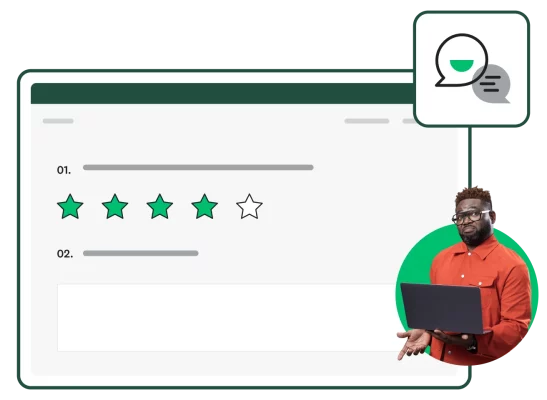8 ways to measure customer satisfaction (feedback methods + KPIs)
Learn how to accurately measure customer satisfaction and use these insights to improve your business performance, CX, and customer loyalty

Measuring customer satisfaction helps companies align their operations with customer expectations. This key metric affects everything from customer loyalty to profit margins.
Calculating your customer satisfaction score with a CSAT survey is a good starting point, but it's essential to understand how customer satisfaction impacts your broader customer experience (CX). We’ll share the strategies, tools, and best practices you'll need to monitor and improve customer satisfaction continuously.
What is customer satisfaction?
Customer satisfaction gauges how well a company's products, services, and brand meet customer expectations. It helps CX teams improve the customer experience and foster customer loyalty.
Measuring satisfaction provides insights into how effectively businesses deliver value to their customers, identifying areas of strength and opportunities for improvement. This understanding can drive strategic decisions across the organization, from refining product offerings to enhancing customer service.
How to measure customer satisfaction
Customer satisfaction KPIs
Customer satisfaction KPIs typically yield scores to reveal how well a company meets customer expectations. Companies can track multiple KPIs simultaneously for a holistic view of customer satisfaction across various dimensions.
Here are three key performance indicators to track:
CSAT (Customer Satisfaction Score)
Customer Satisfaction Score (CSAT) measures immediate customer satisfaction with a product, service, or experience. Typically, businesses send a CSAT survey asking customers to rate their satisfaction on a scale from 1 (very unsatisfied) to 5 (very satisfied). The company then calculates the percentage of responses that are 4 (satisfied) or 5 (very satisfied) to get their CSAT score.
For example, let's say you get 100 responses to a CSAT survey. 50 people rated their satisfaction (4), and 30 people indicated they were very satisfied (5). Divide the total number of positive ratings (80) by 100 to calculate your CSAT score: (80/100) x 100 = 80%. This CSAT score indicates that 80% of your customers were satisfied or very satisfied with their experience.
NPS (Net Promoter Score®)
The Net Promoter Score (NPS) assesses customer loyalty and whether a customer will recommend a company's products or services. The process involves sending an NPS survey with one fundamental question: "How likely are you to recommend our company/product/service to a friend or colleague?"
The NPS formula uses a scale of 0-10 to classify customers as detractors, passives, or promoters. Subtract the percentage of detractors from the percentage of promoters, and you get an NPS score.
For example, if out of 100 survey responses, 70 are promoters (rating 9 or 10), 20 are passives (rating 7 or 8), and 10 are detractors (rating 0 to 6), you calculate the NPS as follows: (70% Promoters - 10% Detractors) = 60%.
Our NPS survey template, NPS calculator, and NPS benchmarks make it easy to find and improve your score.
CES (Customer Effort Score)
Customer Effort Score (CES) evaluates how much effort a customer must expend to get an issue resolved, a request fulfilled, or a product used. CES surveys ask customers to rate the ease of their experience using a numerical scale. The score is calculated by averaging these ratings, helping companies identify how to make customer interactions smoother and more satisfying.
For example, 100 customers rate the ease of their experience on a scale from 1 (very difficult) to 5 (very easy). The average of all one hundred responses is 4.2, indicating that customers found interacting with your service or product easy, which can indicate efficient customer support and processes.

Customer feedback surveys
Regular customer feedback surveys help organizations monitor how perceptions of their brand evolve. These surveys typically do not generate a specific "score," but the feedback gathered reveals customer sentiments, highlights customer experience gaps, and pinpoints areas for improvement.
Here are five customer feedback surveys businesses commonly use to learn about their customers:
- Customer experience survey: This survey collects feedback on whether your service meets customer needs and how responsive your team is to inquiries. Customer experience surveys track changes over time, allowing businesses to tailor interactions and improve customer relations. Conduct this survey every 3-6 months to align with customer expectations and adapt strategies as needed.
- Customer service feedback survey: Use this survey to evaluate customer satisfaction with your service team. Questions assess response times, understanding of the customer's issue, and the likelihood of recommending your company. The insights help train and support your customer service team to enhance service quality.
- Customer onboarding satisfaction survey: Try this survey when you want to measure new customers' satisfaction with onboarding. Identify strengths and weaknesses in your onboarding and adjust practices to improve initial customer experiences.
- Brand performance survey: Explores what drives customers to choose your products and how they perceive the value offered. This survey, featuring questions on product quality, design, and price, assists in understanding how well your brand meets market expectations.
- Customer analysis survey: B2B companies use this survey to collect data about their clients' customers. This data helps them better understand their clients' needs and market conditions. This feedback is crucial for tailoring products or services to fit clients' strategies and customer bases.
Online reviews
Monitoring online reviews offers a straightforward method for tracking customer satisfaction and sentiment over time. People often post reviews when they’re very satisfied or dissatisfied, making reviews a valuable source of unfiltered feedback.
Here are some ways you can use reviews to measure customer satisfaction:
- Identify improvement areas: Reviews highlight what customers appreciate or dislike. Paying attention to common complaints can pinpoint urgent areas for improvement.
- Spot trends and patterns: Analyzing reviews helps detect emerging trends in customer behavior and preferences. These insights can guide strategic adjustments and innovation.
- Gather authentic feedback: Since people post reviews voluntarily, they provide genuine insights into customer experiences and expectations.
Reviews can be challenging to track across multiple channels, including social media. Companies often use listening tools to monitor review platforms and social media channels efficiently. These tools allow businesses to set up alerts for specific keywords or phrases, ensuring they stay informed about real-time customer feedback and sentiment.
Customer complaints
Customer complaints are a critical resource for rapid improvement. They highlight urgent issues and provide direct insights into what needs fixing. Here are three steps to managing complaints effectively to enhance customer satisfaction:
- Collect across channels: To fully understand customer discontent, gather complaints from diverse sources beyond online reviews and surveys. Include data from focus groups, interviews, and sales calls.
- Take action: Don't just record complaints—respond to them. Develop a strategy to address complaints swiftly and effectively.
- Follow up: Engage directly with customers who have voiced complaints. A follow-up can turn a negative experience into a positive one and demonstrate your commitment to customer satisfaction.
By actively addressing complaints and implementing solutions, organizations can improve their products and services, enhancing overall customer satisfaction.
Why measure customer satisfaction?
Measuring customer satisfaction is vital for any business to thrive in today's competitive market. It provides actionable insights, helps allocate resources effectively, and directly impacts your bottom line. Understanding customer satisfaction can transform your service, product development, and marketing approach.
Understand your customer's needs and pain points better
Measuring customer satisfaction sheds light on what your customers truly value and the challenges they face with your products or services. This understanding enables you to tailor your offerings to meet their needs better and resolve pain points, resulting in a better customer experience.
Boost customer retention
Satisfied customers are more likely to stay loyal to your brand. By measuring satisfaction, you can identify the key factors that retain customers. This insight helps you strengthen those aspects and ensure a high retention rate.
Reduce customer churn (and churn costs)
Understanding dissatisfaction through measurement allows you to address issues before customers leave. Reducing churn not only retains valuable customers but also cuts the high costs of acquiring new ones.
"The Effortless Experience" by Matthew Dixon, Nick Toman, and Rick DeLisi explores how reducing customer effort—when measured with a CES survey—can increase customer loyalty and reduce churn.

Boost customer acquisition
Positive customer feedback and satisfaction are powerful tools for attracting new customers. High satisfaction scores and glowing reviews can persuade potential customers to choose your brand over competitors.
Boost your company's brand reputation
High customer satisfaction enhances your brand's image and reputation. Satisfied customers are more loyal, and often share their positive experiences and advocate for your brand. This word-of-mouth promotion is invaluable and can significantly elevate your market standing.
Close gaps in customer experience
Measuring satisfaction helps pinpoint weaknesses in your customer experience. These insights allow you to close gaps and create a seamless experience from initial contact through post-purchase support.
Allocate resources to fix problem areas
Regularly measuring customer satisfaction can highlight the most pressing issues and where to allocate resources for maximum impact. Companies can use this feedback to prioritize and allocate resources to address these concerns in the most effective way possible.
Increase sales and revenue
Lastly, satisfied customers are more likely to make repeat purchases and try new offerings. You can drive sales, increase revenue, and foster sustainable growth by continually measuring and responding to customer satisfaction.
How to improve customer satisfaction
Companies can enhance customer satisfaction and loyalty by implementing targeted strategies across every aspect of the customer experience, from initial feedback to personalized interactions.
Collect and review customer feedback regularly
Frequent collection and analysis of customer feedback allow businesses to stay aligned with customer needs and expectations. Quick responses to this feedback can significantly enhance the customer experience. By reducing response times, companies show they value customer input, leading to increased satisfaction and loyalty.
Continuously improve the customer journey
Continuously assess and refine your customer journey to identify stages where customers face difficulties and implement changes to smooth these points. Integrating feedback automation can help streamline processes, reduce friction, and enhance satisfaction.
Empower employees through training
Regular training programs equip staff with the necessary skills to meet and exceed customer expectations. Empowered employees contribute to better service quality and higher customer satisfaction levels.
Invest in company culture
Culture is closely linked to training. A strong culture improves employee morale and service quality. Happy and engaged employees deliver better customer service, boosting satisfaction and fostering brand loyalty.
Personalize the customer experience
Companies can use customer data to personalize experiences to individual preferences. This personal approach makes customers feel valued and can significantly enhance their perception of the brand.
For example, a brand using browsing history and purchase data can recommend products tailored to individual customers, enhancing their shopping experience by making it more relevant and enjoyable.
Learn from disgruntled customers
Effective complaint management can transform dissatisfied customers into loyal ones. Companies that excel in handling complaints see enhanced customer loyalty and improved brand perception.
Measure and improve customer satisfaction with SurveyMonkey
Measuring and improving customer satisfaction are essential practices that enable businesses to align closely with customer expectations, enhance service quality, and ultimately drive brand loyalty and growth.
Learn more about how SurveyMonkey can help to improve your customer satisfaction today.
NPS, Net Promoter & Net Promoter Score are registered trademarks of Satmetrix Systems, Inc., Bain & Company and Fred Reichheld.
Discover more resources

Customer satisfaction survey templates
Explore our customer satisfaction survey templates to rapidly collect data, identify pain points, and improve your customer experience.

CSAT calculator: Measure and interpret customer satisfaction
Is your company meeting customer expectations? Use our free CSAT calculator to assess your Customer Satisfaction score and drive profits.

Customer Behavior Analysis: A Complete Guide and Examples
Read our step-by-step guide on conducting customer behavior analysis. Learn how to collect data and improve customer touchpoints.

Empowering CX professionals: Using insights to overcome frontline challenges
Empower your CX team with actionable insights! Watch our webinar for expert strategies on boosting performance and morale.